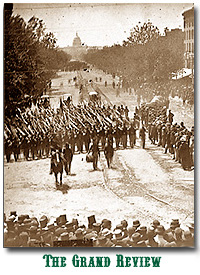1861
| 1862 | 1863 |
1864
Regimental
History: 1865
 ith their
numbers greatly reduced, the
officers and men who had re-enlisted or whose term of service had not
expired were formally reorganized into a five-company battalion known
henceforth as the 28th Battalion Massachusetts Volunteers. Capt. John
Connor made his troops ready for the coming campaign until Maj. Fleming
returned in early January.
ith their
numbers greatly reduced, the
officers and men who had re-enlisted or whose term of service had not
expired were formally reorganized into a five-company battalion known
henceforth as the 28th Battalion Massachusetts Volunteers. Capt. John
Connor made his troops ready for the coming campaign until Maj. Fleming
returned in early January.
 As the war wound down, the men of the
28th Massachusetts were reunited with their proud old comrades in a
reconstituted Irish Brigade, which Col. Robert Nugent, former commander
of the 69th New York, had worked diligently to establish after the
original brigade was disbanded in June 1864. Recruiting resumed in fall
1864. All three of the old New York units were brought back up to
strength and the 28th Massachusetts returned to the fold.
As the war wound down, the men of the
28th Massachusetts were reunited with their proud old comrades in a
reconstituted Irish Brigade, which Col. Robert Nugent, former commander
of the 69th New York, had worked diligently to establish after the
original brigade was disbanded in June 1864. Recruiting resumed in fall
1864. All three of the old New York units were brought back up to
strength and the 28th Massachusetts returned to the fold.
Nugent was rewarded with command of the
"new" Irish Brigade not only because he worked so tirelessly to pull it
back together, but also because he maneuvered to prevent the 116th
Pennsylvania Infantry from returning. That unit's commander, Col. St.
Clair Mulholland, would have assumed command of the brigade by virtue
of having greater seniority than Nugent. The 7th New York Heavy
Artillery was first attached to the brigade in place of the 116th
Pennsylvania, then was replaced in February by the 4th New York Heavy
Artillery.
Numbering some 185 men fit for duty, the
28th Massachusetts joined faithfully with the Irish Brigade in a number
of actions around Petersburg during spring 1865. Most significant for
the battalion was the battle at Hatcher's Run, fought on March 25.
Immediately following the successful repulse
of the Confederate attack on Fort Stedman, Gen. Meade ordered the 2nd
Corps to assault the rebel entrenchments on the far left end of the
line in anticipation of a breakthrough. The 28th Massachusetts led the
way in this advance, capturing outer picket lines thought to be
impregnable. The men then held tenaciously to their position, repulsing
two determined Confederate charges launched from the main line.
As the rebels moved around the right flank
of the Irish Brigade, the 28th was exposed to a withering crossfire
that left 71 casualties, including Lt. Thomas Parker, who was mortally
wounded. The Irish steadfastly held their position, expended most of
their ammunition, and retired only when relieved by units from the 5th
Corps late in the day. Among the many wounded was Maj. Fleming, who had
been in his usual place at the front of the regiment.
On April 2 came what would turn out to be
the last engagement in which the 28th Massachusetts fought, at
Sutherland Station along the South Side Rail Road. After nine long
months of siege, Grant's army finally broke through the Confederate
entrenchments and captured Petersburg.
In this battle, the Irish Brigade was sent
forward to attack the rear guard protecting Lee's now retreating army.
The first effort was repulsed due to enfilading fire of artillery, but
a second push launched soon after was successful in taking the
Confederate works. The Irish took more than 150 rebel prisoners, along
with two cannon and a battle flag. Once again, the battalion lost its
commanding officer, this time Capt. Patrick Black, who had succeeded
the wounded Fleming.
 The 28th Massachusetts then embarked on
long, hard marches in pursuit of Lee's army. On April 4, the battalion
had a chance meeting with Maj. Gen. Phil Sheridan, a fellow Irishman
who saluted the unit to the cheers of jubilant soldiers. The 28th was
present but not actively engaged at Sailor's Creek on April 6 and
Farmville on April 7.
The 28th Massachusetts then embarked on
long, hard marches in pursuit of Lee's army. On April 4, the battalion
had a chance meeting with Maj. Gen. Phil Sheridan, a fellow Irishman
who saluted the unit to the cheers of jubilant soldiers. The 28th was
present but not actively engaged at Sailor's Creek on April 6 and
Farmville on April 7.
Following Lee's surrender at Appomattox
Courthouse on April 9, the battalion encamped at Burkesville, Virginia,
for nearly a month. The 28th Massachusetts returned to Washington,
D.C., on May 15 under the command of Capt. Patrick H. Bird. The
battalion marched in the Grand Review down Pennsylvania Avenue on May
23, every man proudly wearing a sprig of evergreen in his forage cap.
The battalion served on guard duty in
Washington until June 25 and was mustered out of federal service five
days later. The veterans of the 28th then traveled back to
Massachusetts together. They were paid and discharged at Readville on
July 5, 1865.


